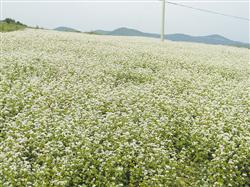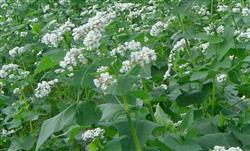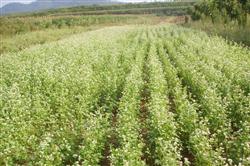How to plant buckwheat in autumn?

How to plant buckwheat in autumn? Please introduce the planting of buckwheat in autumn with reference to the following methods: first, sowing at the right time. Buckwheat likes warm and cool environment, is afraid of frost, and sows too early or too late, which will seriously affect the yield. The suitable sowing date for the south area along the Yangtze River in our province is around the middle of August, and the suitable sowing date for the area along the Huaihe River is the first and middle of August. Second, select improved varieties. Buckwheat varieties with strong stress resistance with a growth period of 70-80 days, such as sweet buckwheat No. 1, sweet buckwheat No. 2, Tartary buckwheat with small safflower, etc., should be selected. It is best to use the new seeds harvested that year. Third, seed treatment. Before sowing, the seeds should be dried for 2-3 days, and then the seeds should be soaked in warm soup, that is, the seeds should be soaked in warm water at 40 degrees Celsius for 10-15 minutes, the floating blighted grains should be removed, and the sunken full grains should be fished out to dry. Seed dressing can be carried out in places where diseases and insect pests are serious. In order to shorten the time from sowing to emergence, soak the seeds in warm soup for 1-2 days, and sow the seeds immediately when the seeds begin to germinate. Fourth, fine ground preparation. The ability of top soil of buckwheat seedlings is poor, the development of root system is weak, and the requirement of soil preparation is high, so we should do a good job of tillage and soil preparation as much as possible. Fifth, increase the application of fertilizer. Buckwheat is resistant to barren, but the suitable application of phosphorus and potassium fertilizer can significantly increase the yield. Fertilizer can be used as seed fertilizer, generally 3-5 kg of diammonium phosphate per mu when sowing, and add appropriate amount of high-quality organic fertilizer. When applying, we should pay attention to separate the chemical fertilizer from the seeds to prevent burning seedlings. Sixth, sowing methods. There are mainly three kinds of broadcast, on-demand and on-demand. Sowing can be divided into two types: first ploughing and then sowing seeds and then sowing seeds before ploughing. On-demand generally sows 5000-6000 holes per mu and 10-15 seeds per hole. The sowing depth is generally 3-4 cm, the sowing rate is generally 2.5-3 kg per mu, and the sowing rate is about 5 kg per mu. Seventh, strengthen the field management. First, it is necessary to remove stains and prevent drought, and ditches should be opened when sowing to prevent waterlogging and death of seedlings. In case of drought in the seedling stage, it is necessary to moisten the soil moisture by ditch irrigation in time, or sprinkle dilute dung water in the morning and evening before emergence. Second, it is necessary to plough and weed in time. In case of rain after sowing, the soil layer should be broken in time. And ploughed and weeded twice in the seedling height of 6-8 cm and before flowering. Third, it is necessary to replenish fertilizer and prevent decline. From flowering to fruiting period, 0.5 kg urea, 200 g potassium dihydrogen phosphate and 60 kg water were sprayed 1-2 times per mu. The fourth is auxiliary pollination. The seed setting rate of natural pollination of buckwheat is low, and artificial pollination should be assisted at flowering stage. It can be pollinated by bees or gently dragged back and forth on the upper layer of the plant with ropes or thin bamboo poles at 8-10:00 in the morning for 2-3 times (3-5 days apart). Fifth, the prevention and control of diseases, pests and rodents, pay attention to the use of low-toxic pesticides. Eighth, harvest in time. Before Frosts Descent, when the seeds of the whole plant were dark brown, we should pay close attention to the early and late harvest, tie up or tie up the handle, and put it in the room, so that the buckwheat was fully ripened. Click to get more buckwheat planting techniques click to get more food crop planting techniques
- Prev

Cultivation techniques of buckwheat
Buckwheat (also known as black wheat, flower wheat or Triticum triticum) has a short growth period, usually only 70-80 days, and has strong adaptability, so it is an ideal replanting crop after the disaster. The main points of planting techniques: buckwheat soil preparation is not strict on soil conditions, regardless of sandy loam, light loam, acid soil, slightly alkaline soil and new reclamation.
- Next

How can autumn buckwheat be planted with high yield?
How can autumn buckwheat be planted with high yield? Please give an introduction to planting methods. Autumn buckwheat can be planted with reference to the following methods: 1. Select high-yield varieties. Main push buckwheat improved variety west buckwheat 1, west buckwheat 2. 2. Early sowing and mixed sowing in due time. Autumn-summer sowing is appropriate, no later than the end of August. Drying before sowing 1...
Related
- The first cup of black tea in spring, the flavor and history of tea gardens in Kenya, Africa
- The computer can not only choose potatoes, but also grow tea rice. AI will grow winter oolong tea champion.
- It is not only the inflated tea bitten by insects, but also engraved with the four seasons tea in Beipu.
- The Oriental Beauty Tea Festival in Zhuxian County takes the stage at the weekend to experience the plus-size feast of oil tea.
- & quot; Oriental Beauty Tea & Exploration of Emei in Hsinchu, the hometown of quot;
- The new variety of strawberry "Tainong 1" dessert is the first choice with mellow aroma. Crimson gorgeous
- History of Tea in Taiwan: from Wild Inner Mountain to Export Tea Garden
- Two types of Taiwan Oriental Beauty Black Tea won the British three-Star Award for Childhood Tea Xiang Zhang Jiaqi changed from pilot to champion tea maker.
- Banana species and varieties: the planting history of Taiwan Xianren banana and dwarf banana is long, is banana disease resistant?
- Coffee planting Technology: Qianjie Coffee from Seedling to harvesting

